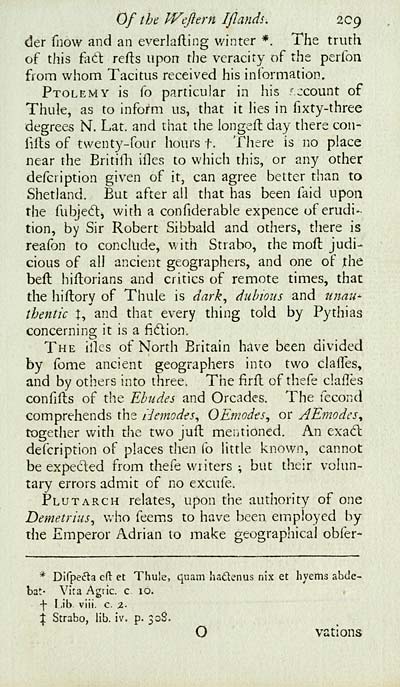Blair Collection > Critical dissertations on the origin, antiquities, language, government, manners, and religion, of the antient Caledonians, their posterity the Picts, and the British and Irish Scots
(247)
Download files
Complete book:
Individual page:
Thumbnail gallery: Grid view | List view

Of the VVeJiern IJlands. zcg
der fnow and an everlafling v/inter *. The truth
of this fdtt refls upon the veracity of the perfon
from whom Tacitus received his information.
Ptolemy is fo particular in his ■ jcount of
Thule, as to inform us, that it hes in fixty-three
degrees N. Lat. and that the longeft day there con-
fifts of twenty-four hours f. There is no place
near the Eritirti iiles to which this, or any other
defciiption given of it, can agree better tiian to
Shetland. But after all that has been faid upon
the fubjeft, with a confiderable expence of erudi-
tion, by Sir Robert Sibbald and others, tliere is
reafon to conclude, with Strabo, the moft judi-
cious of all ancient geographers, and one of the
bed hiftorians and critics of remote times, that
the hiftory of Thule is dark, dubious and unau-
thentic I, and that every thing told by Pythias
concerning it is a fidion.
The illcs of North Britain h<1ve been divided
by fome ancient geographers into two claifes,
and by others into three. The firfl of thefe clailes
confifts of the Ebudes and Orcades. The fecond
comprehends the liemodes, OEmodes, or AEmodes^
together with the two jufl meijtioned. An exadl
defcription of places then fo little known, cannot
be expeded from thefe writers ; but their volun-
tary errors admit of no excufe.
Plutarch relates, upon the authority of one
Demetrius, v/ho feems to have been employed by
tlie Emperor Adrian to make geographical obfer-
* DIfpedta efl: et Thule, quam Iiadenus nix et hyertts abde-
bat- Vita Agric. c lO.
f Lib viii. c 2-
i Strabo, lib. iv. p. 30S.
O vations
der fnow and an everlafling v/inter *. The truth
of this fdtt refls upon the veracity of the perfon
from whom Tacitus received his information.
Ptolemy is fo particular in his ■ jcount of
Thule, as to inform us, that it hes in fixty-three
degrees N. Lat. and that the longeft day there con-
fifts of twenty-four hours f. There is no place
near the Eritirti iiles to which this, or any other
defciiption given of it, can agree better tiian to
Shetland. But after all that has been faid upon
the fubjeft, with a confiderable expence of erudi-
tion, by Sir Robert Sibbald and others, tliere is
reafon to conclude, with Strabo, the moft judi-
cious of all ancient geographers, and one of the
bed hiftorians and critics of remote times, that
the hiftory of Thule is dark, dubious and unau-
thentic I, and that every thing told by Pythias
concerning it is a fidion.
The illcs of North Britain h<1ve been divided
by fome ancient geographers into two claifes,
and by others into three. The firfl of thefe clailes
confifts of the Ebudes and Orcades. The fecond
comprehends the liemodes, OEmodes, or AEmodes^
together with the two jufl meijtioned. An exadl
defcription of places then fo little known, cannot
be expeded from thefe writers ; but their volun-
tary errors admit of no excufe.
Plutarch relates, upon the authority of one
Demetrius, v/ho feems to have been employed by
tlie Emperor Adrian to make geographical obfer-
* DIfpedta efl: et Thule, quam Iiadenus nix et hyertts abde-
bat- Vita Agric. c lO.
f Lib viii. c 2-
i Strabo, lib. iv. p. 30S.
O vations
Set display mode to: Large image | Transcription
Images and transcriptions on this page, including medium image downloads, may be used under the Creative Commons Attribution 4.0 International Licence unless otherwise stated. ![]()
| Permanent URL | https://digital.nls.uk/76289328 |
|---|
| Description | A selection of books from a collection of more than 500 titles, mostly on religious and literary topics. Also includes some material dealing with other Celtic languages and societies. Collection created towards the end of the 19th century by Lady Evelyn Stewart Murray. |
|---|
| Description | Selected items from five 'Special and Named Printed Collections'. Includes books in Gaelic and other Celtic languages, works about the Gaels, their languages, literature, culture and history. |
|---|

